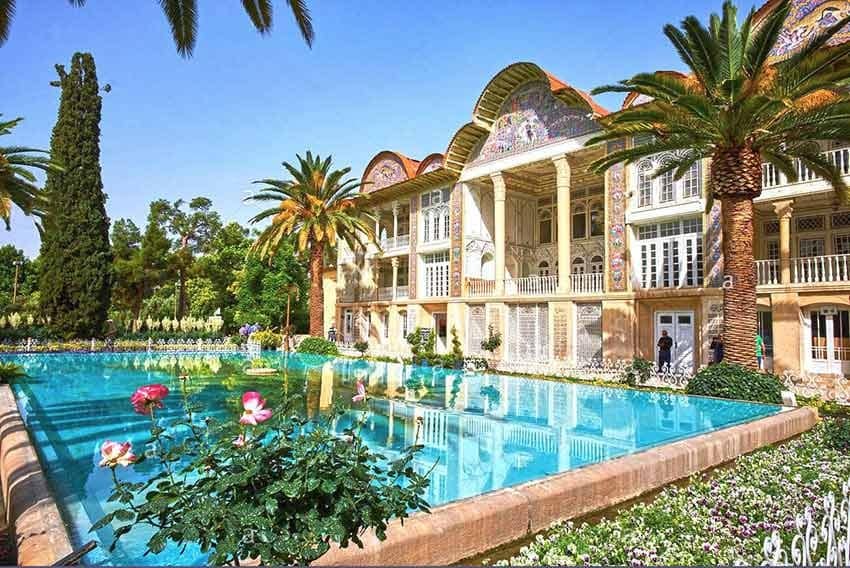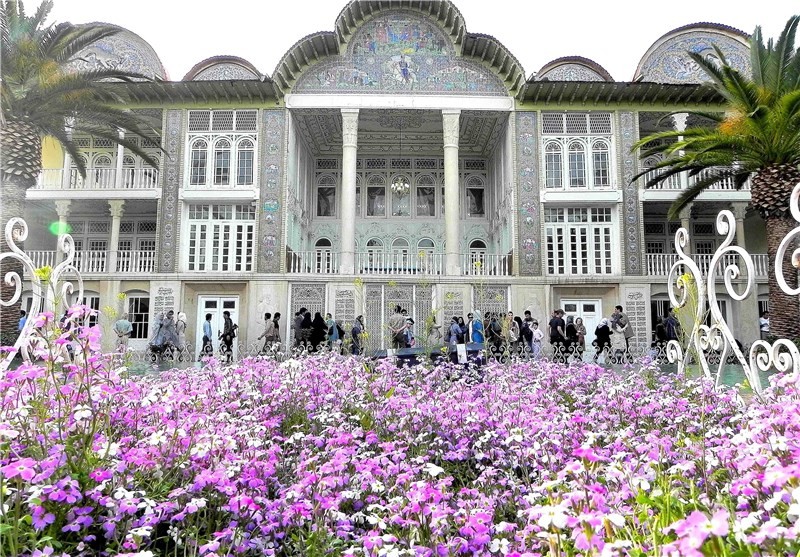Eram Garden: The Quintessence of Persian Landscape

Whenever you embark on a journey to Shiraz, you’ll find more captivating places waiting to be explored, each tempting you to save it for your next visit. One of Shiraz’s remarkable attractions is its diverse array of gardens, from the charming Afif-Abad and Eram Gardens to the delightful Delgosha and Bagh-e Jahan Nama. Among them all, Eram Garden stands as the crowning jewel.
Eram Garden is the heart of Shiraz’s greenery, a botanical wonderland that reveals many hidden treasures. Understanding the historical backdrop of this garden adds to its allure. While the exact date of Eram Garden’s creation remains shrouded in mystery, historical accounts hint at its existence in travelogues dating back to the 10th and 11th centuries.
Travelers during the Safavid era praised Eram Garden for its grandeur, but the garden’s historical journey goes even further. It dates back to the Seljuk and Atabeg periods, with Karim Khan Zand, during his reign, undertaking maintenance and preservation efforts. In the late Zand era, Eram Garden belonged to the Qashqai tribal chiefs.
The primary structure of Eram Garden was built during the reign of Fath Ali Shah Qajar by the first Qashqai Atabeg and his son, Mohammad Ali Khan. During Naser al-Din Shah’s rule, Haj Nasir al-Mulk Shirazi purchased the garden and constructed a mansion within it, the same mansion you’ll see today. Haj Mohammad Hasan Khan, one of Shiraz’s most renowned architects, designed this mansion.
Besides Eram Garden, the legacy of Nasir al-Mulk includes other valuable structures in Fars Province, such as the Nasir al-Mulk House and Mosque.
Eram Garden once belonged to the Qavam family, confiscated during the Pahlavi era, and later handed over to Shiraz University. Today, the garden houses the Botanical Garden under the Faculty of Agriculture and the mansion belongs to the Faculty of Law.
The name “Eram” has its own unique story. The garden was named Eram in reference to a grand mansion and garden built by Shaddad ibn ‘Ad, the Arabian king, in competition with paradise itself.
Eram Garden was officially registered as a national heritage site in 1974. Five years later, in 1979, it underwent extensive restoration and renovation under the supervision of the Cultural Heritage Organization. In 2011, Eram Garden was inscribed on the UNESCO World Heritage List during the 35th session of the UNESCO World Heritage Committee.
Contents
Architectural Marvels of Eram Garden

Eram Garden is constructed on a rectangular plot of land covering 110,000 square meters. The main entrance gate, located on the larger side, faces north towards “Eram Boulevard,” while the smaller side leads to the west and the former “Jame Jam Boulevard,” now known as the “Saat Taei Square.” These two sides, once adorned with floral walls, have now been replaced with short walls and railings, covered with jasmine and pomegranate vines.
Other parts of the garden are bounded by other gardens and residential houses. Eram Garden boasts a rich diversity of plant species, with a wide array of flora from different parts of the world, turning it into a museum and exhibition of various flowers and plants you might have never seen before.
The garden features ornamental trees, cypresses, orange trees, and various decorative flowers. As you step into the garden, you’ll be greeted by centuries-old cypress trees, citrus orchards, a large pool in front of the mansion, and the three-story mansion with its iconic rotating turrets, one of the first things you’ll notice. One of the most beautiful and significant sections of Eram Garden is the east-to-west passageway.

As you enter Eram Garden from the main entrance, this passageway proudly unfolds on your left side. The majestic rows of Italian cypress trees, several centuries old, line both sides of this passageway, creating a mesmerizing spectacle that can captivate any onlooker.
Notably, among these Shirazi cypress trees, there is one that stands taller and more imposing than all the rest, casting its breathtaking presence from a distance. This tree is the famous Thousand-Year-Old Cypress of Eram Garden, soaring to approximately 35 meters in height, earning its title as the tallest cypress tree in Shiraz.
The trees in Eram Garden can be categorized into two groups:
Ornamental Trees
Cypress, pine, tamarisk, oleander, willow, black locust, plane tree, poplar, palm (Phoenix dactylifera), and eucalyptus.
Fruit Trees
Pomegranate, fig, orange, sour orange, grapefruit, lemon, and a variety of stone fruit trees.
As you wander further into the garden, you’ll encounter a harmonious blend of nature and culture. The tranquil surroundings, combined with the scent of flowers and the gentle sound of flowing water, create a serene atmosphere that enchants visitors. The pathways in Eram Garden have been designed to complement the natural beauty, and their well-kept condition allows for pleasant strolls.
Eram Garden is a testament to the harmonious coexistence of nature and human creativity. The combination of flowing water, lush vegetation, and architectural marvels is a true feast for the senses. Whether you’re a nature enthusiast, an architecture lover, or someone seeking tranquility, Eram Garden has something special to offer.
Eram Garden’s Water Features
Water plays a pivotal role in the charm of Eram Garden. The garden is renowned for its intricate irrigation system, which has been carefully designed to distribute water evenly throughout the entire garden. The network of water channels, fountains, and pools creates a soothing soundscape that enhances the garden’s tranquility.

One of the standout water features in Eram Garden is the rectangular pool located in front of the mansion. This pool covers an area of approximately 335 square meters and is adorned with a beautiful fountain. Each corner of the pool is graced by magnificent date palms, adding to the pool’s aesthetic appeal. The pool is enclosed by 18 large stone slabs, providing a serene and reflective surface.
The water for this pool is sourced from a nearby stream that flows from the basement of the mansion. Additionally, Eram Garden boasts two wells used for watering the trees and plants in the garden.
In the northwest corner of the garden, a small pond comes into view as you pass through an irregular yet beautifully crafted stone gateway. This pond is surrounded by lush greenery, with tall trees providing shade from the sun. Large rocks adorn the pond’s edges, providing comfortable seating where you can relax and admire the colorful fish swimming in the pond.
Eram Garden’s Layout Plan
Eram Garden was originally designed in accordance with the principles of traditional Iranian architecture, characterized by balanced forms, harmony, and straight lines. However, over time, due to various renovations and alterations, the garden has incorporated elements of non-Iranian architectural styles, such as Japanese influences. Changes in the overall layout of the garden have also influenced its geometric structure.

The early plan of Eram Garden, seen in historical images, closely adhered to the principles of traditional Persian garden design, with symmetrical and harmonious elements. However, subsequent renovations and redesigns introduced non-Iranian architectural styles and altered the garden’s original layout.
Despite these modifications, the garden still retains its unique charm and character, blending elements from different architectural traditions to create a truly distinct atmosphere.
The Eram Garden Mansion
The centerpiece of Eram Garden is the Eram Mansion, also known as the main mansion. Located atop a gentle slope within the garden, this mansion is a three-story structure with two grand columns inspired by the columns of Persepolis. The mansion is particularly renowned for its exquisite interior decorations, including oil paintings, stucco work, exquisite carvings, and unique tilework.
The mansion is a prime example of Qajar-era architecture and is considered one of the most significant architectural achievements of the Qajar period. Its design draws inspiration from the architectural styles of both the Safavid and Zand eras, creating a harmonious blend of traditional Persian aesthetics.

The lower floor of the mansion houses the basement, which was designed to provide respite from the scorching summer heat. The basement features a flowing water channel supplied by the stream mentioned earlier, enhancing the interior’s pleasant ambiance. The floors and walls of the basement are adorned with colorful tiles, adding to its visual appeal.
At the front of the mansion, you’ll find a prominent tableau and two circular alcoves. Together, they form a trio of crescents connected to each other, depicting scenes from the Shahnameh and historic battles of the Qajar era. Another notable architectural feature of the mansion is its iron windows.
Three ornate iron lattice windows adorn the first floor, leading to the entrance of the reflecting pool. Additionally, one large central window and two sidelights with stained glass are found on the second floor, showcasing their historical significance.
Most of the wooden doors in Eram Garden are crafted from cedar wood, known for its durability. Despite the passage of time, these doors have remained remarkably intact, retaining their original appearance.
In summary, Eram Mansion, with its oil paintings, intricate wooden doors, decorative iron windows, stone arches, stucco work, and tile decorations, stands as a prominent artistic achievement of the Qajar period. Its restoration and preservation efforts have ensured that this architectural masterpiece continues to captivate visitors with its timeless beauty.
Restoration and Conservation of Eram Garden
Eram Garden faced a period of neglect and deterioration during the late Pahlavi era, transforming it into a dilapidated ruin. The once-floral walls were no more, and the garden had lost its former charm. The initial restoration efforts took place during this period.
First, the garden’s floral walls were replaced with low stone walls, adorned with metal railings covered in jasmine and pomegranate vines. Then, the Eram Mansion was meticulously restored, paying homage to its original design. The grand hall, oil paintings, stucco work on the walls and ceilings, and the tilework on the courtyard walls underwent extensive conservation work.

Eram Garden is adorned with various inscriptions and plaques, most of which were installed during the reign of Nasir al-Mulk. Six inscriptions are situated on the eastern façade of the main mansion. These inscriptions are meticulously carved into marble slabs and feature elegant Nastaliq calligraphy, along with their respective installation dates.
Two monumental inscriptions are located on either side of the large courtyard of the mansion. Both inscriptions depict soldiers from the Achaemenid era, holding a spear in one hand and a mace in the other. While they bear some resemblance to the soldiers of Persepolis, the intricate details and unique decorative elements set them apart.
Several inlaid mosaic inscriptions in the garden, created using colored tiles, add further value to the architectural and cultural significance of Eram Garden.
Visiting Eram Garden

Eram Garden welcomes visitors every day from 8:00 AM to 8:30 PM. To enter the garden, you will need to purchase a ticket. If you happen to be a student, you can enjoy a discounted rate by presenting your student ID, as Eram Garden is under the ownership of Shiraz University.
Please note that Eram Garden is closed on the following dates:
- Tasu’a and Ashura
- 21st of Ramadan (Imam Ali’s martyrdom)
- 28th of Safar (Prophet Muhammad’s passing)
- 14th of Khordad (Imam Khomeini’s passing)
- 25th of Shawwal (Imam Ja’far al-Sadiq’s martyrdom)
The Best Time to Visit Shiraz
Shiraz, being a city with a moderate climate and four distinct seasons, offers a unique experience throughout the year. However, the month of Ordibehesht (April-May) holds a special place in the hearts of travelers. During this time, Shiraz showcases the true wonder of spring, turning the city into a floral





Hi, do you describe this garden as being small? It’s about 11 hectares. You’re eally disappointing.
Hi, do you describe this garden as being small? It’s about 11 hectares. You’re eally disappointing. It’s also a world heritage site of UNESCO.
“has no world renowned antiquities on display, unlike the Louvre.” !!?? This is a UNESCO world heritage site and IS ITSELF an antiquity!! Lol